Chapter 13
Email on Your iPad
In this chapter, we will help you explore the world of email in the Mail app on your iPad. You will learn how to set up multiple email accounts, check out all the various reading options, open attachments, and clean up your Inbox.
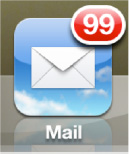
You will be pleased with the unified inbox feature that lets you see all your email in a single inbox. You also have the option to view threaded messages, where all messages related to a single topic (replies, forwards, and so on) are kept together in a single group. Or, if you prefer, you can turn off this feature in the Settings app.
And for cases when your email is not working quite right, you will learn some good troubleshooting tips to help you get back up and running.
Getting Started with Mail
Setting up email on your iPad is fairly simple. You can sync email account settings from iTunes (see the “Sync Email Account Settings” section in Chapter 3: “Sync Your iPad with iTunes”), or you can set up email accounts directly on your iPad. You do need a network connection to get email up and running.
A Network Connection Is Required
Mobile email is certainly all the rage today. You can view, read, and compose replies to emails already synced to your iPad without a network connection; however, you will need to have Wi-Fi network connectivity to send and/or receive email from your iPad. Check out Chapter 5: “Wi-Fi and 3G Connectivity” to learn more. Also check out the “Reading the Top Connectivity Status Icons” section in the Quick Start Guide in Part 1.
TIP: If you are taking an airline trip, simply download all your email before you get on the airplane; this lets you read, reply, and compose your messages while offline. One important point here—you may only have the email header downloaded before you go offline unless you tap the message to open and view it. In other words, before you take off, make sure you tap to open all important email messages to make sure the full messages get downloaded to your iPad. Any emails you compose on your iPad while offline will be sent after you land and re-establish your connection to the Internet.
Setting up Email on the iPad
You have two options for setting up your email accounts on the iPad:
- Use the iTunes app to sync email account settings.
- Set up your email accounts directly on the iPad.
If you have a number of email accounts that you access from an email program on your computer (e.g., Microsoft Outlook, Entourage, and so on), then the easiest approach is to use iTunes to sync your accounts. See the “Sync Email Account Settings” section in Chapter 3: “Sync Your iPad with iTunes” for more information on this topic.
If you only have a few accounts, or you do not use an email program on your computer that iTunes can sync with, then you will need to set up your email accounts directly on the iPad.
Entering Passwords for Email Accounts Synced from iTunes
In the “Sync Email Account Settings” section of Chapter 3, we showed you how to sync your email account settings to your iPad. After this sync completes, you should be able to view all of theemail accounts on your iPad by opening the Settings app. All you will need to do is enter the password for each account.
The easy way is to enter account passwords is to type them into the pop-up window as you see the window appear.
Type your Password and tap OK to save it.
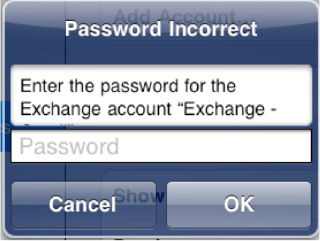
You can also enter your email account passwords and adjust other account details in the Settings app. To enter your password for each synced email account, follow these steps (see Figure 13–1):
- Tap the Settings icon.
- Tap Mail, Contacts, and Calendars in the left column.
- Under Accounts in the right column, you should see all your synced email accounts listed.
- Tap any listed email account, then tap Account to get to the Account details screen.
- Type the account Password and click Done.
- Repeat for all listed email accounts.

Figure 13–1. Entering passwords for each email account synced from the iTunes app
Adding a New Email Account on the iPad
To add a new email account on your iPad, follow these steps:
- Tap the Settings icon.
- Tap Mail, Contacts, and Calendars.
- Tap Add Account below your email accounts.
TIP: To edit any email account, just touch that account.
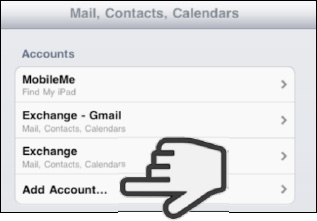
- Choose which type of email account to add on this screen:
- Tap Microsoft Exchange if you use a Microsoft Exchange email server, use Hotmail or Gmail, and you want to sync your contacts and calendar wirelessly.
- Tap Gmail if you use Gmail and do not want your contacts synced wirelessly.
- Tap MobileMe, Yahoo, or Aol if you use these services.
- Tap Other to set up a different type of account.
TIP: Learn more about Google/Hotmail/Microsoft Exchange and MobileMe in Chapter 4: “Other Sync Methods.”
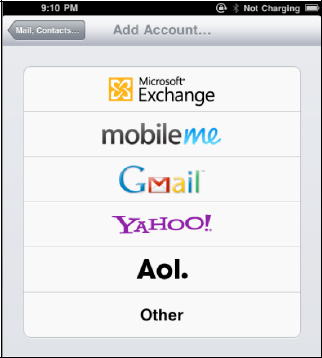
- If you select Other from the account type, then you will see this screen, where you can add the following types of accounts: Mail, Contacts, and Calendars.
- To add an account to Mail, tap Add Mail Account.
- To add an account to Contacts, tap Add LDAP Account or Add CardDAV Account.
- To add an account to Calendars, tap Add CalDAV Account or Add Subscribed Calendar.
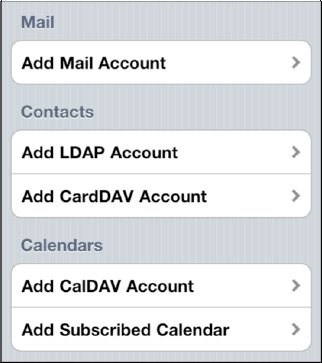
- Now you will be able to enter your login credentials. Type your name as you would like others to see it when they receive mail from you into the Name field. If you selected a Contacts or Calendars type of account, then you would be need to enter the Server name, User Name, Password, and Description.
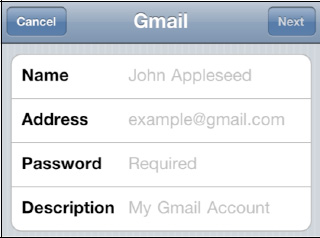
- Next, add the appropriate information into the Address, Password, and Description fields.
- Tap the Next button in the upper-right corner.
Specifying Incoming and Outgoing Servers
Sometimes, the iPad will not be able to automatically set up your email account. In these cases, you will need to type in a few more settings manually to enable your email account.
TIP: You may be able to find the settings for your email provider by doing a web search for your email provider's name and “email settings.” For example, if you use Windows Live Hotmail(formerly known as Hotmail), then you might search for “Microsoft Exchange, POP, or IMAP email settings for Windows Live Hotmail.” If you cannot find these settings, then contact your email provider for assistance.
If the iPad is unable to log into your server with only your email address and password, then you see a screen similar to this one.
Under Incoming Mail Server, type the appropriate information into the Host Name, User Name, and Password fields. Usually, your incoming mail server is something like mail.name_of_your_isp.com.
To adjust the name of your outgoing server, tap Outgoing Mail Server. You can adjust the outgoing mail server on the following screen. These server names usually look like either smtp.name_of_your_isp.com or mail.name_of_your_isp.com.
You can try to leave the Server Name and Password fields blank. If that doesn't work, you can always go back and change them.
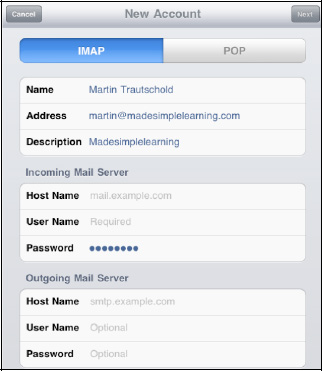
You may be asked if you want to use SSL (secure socket layer), a type of outgoing mail security that may be required by your email provider. If you don't know whether you need it, just check the required mail settings with your email provider.
TIP: The authors recommend that you use SSL security whenever possible. If you do not use SSL, then your login credentials, messages, and any private information is sent in plain text (unencrypted), leaving it open to snoopers.
Verifying that Your Account Is Set Up
Once all the information is entered, the iPad will attempt to configure your email account. You may get an error message; if that happens, you need to review the information you input.
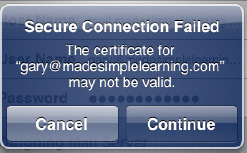
If you are taken to the screen that shows all your email accounts, look for the new account name.
If you see it, your account was set up correctly.
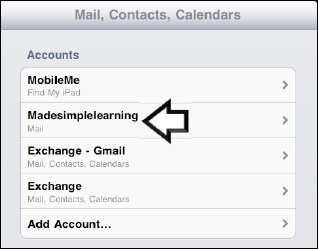
Fixing the Cannot Get Mail Error
If you tap Mail icon and you receive an error that says “Password Incorrect,” you will need to enter your password and click OK to see your email.
Review this chapter's “Enter Passwords for Email Accounts Synced from iTunes” section for additional help.
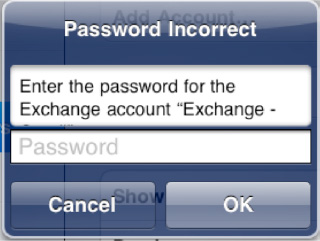
Email Basics
In this section, we give you a guided tour around your Mail app. We explain how to use it in both Portrait and Landscape modes, as well as how to perform the basics of reading, replying, filing, printing, and deleting messages.
Portrait and Landscape Mail Screens
Now that you have set up your email accounts on your iPad, it's time to take a brief tour of the Mail app. To better understand how to get around your Mail program, it helps to have a picture of how your Mail app looks in Portrait and Landscape views (see Figure 13–2).
In Landscape view, you always see your Inbox or Mailboxes in the left column with the email message in the right.
In Portrait view, you see the entire email message fill the screen. To see the Inbox or Mailboxes in a vertical pop-up window on the left side of the page, tap the Inbox button in the upper-left corner of the page.

Figure 13–2. Portrait and Landscape view Mail screens
TIP: If you are setting your iPad down on a desk or holding it in your lap, then you may want to use the Portrait Lock icon to lock your view in Portrait (vertical) mode. This will prevent the image from flipping around unnecessarily. To lock the view, follow these steps:
- Double-tap the Home button and swipe left to right.
- Tap the Portrait Lock button to lock the screen in Portrait mode.
Viewing Messages and the Unread Message Blue Dot
Tap any email message to view it In the main window.
Any unread messages are marked with a Blue Dot icon ![]() to the left of the message.
to the left of the message.

Adjusting Mail Font Size
While we're on the topic of email, let's look at a useful tip on how to increase the font size of your email messages. You can go from the default of 10 or 12 points all the way up to 56 points (see Figure 13–3).
- Tap Settings.
- Tap General.
- Tap Accessibility (right column).
- Tap Large Text and then select the font size you desire.
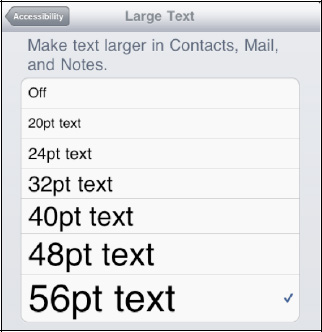

Figure 13–3. Various font sizes in an email
Viewing Your Mailboxes (Inboxes and Account Folders)
The top-level screen is your Mailboxes screen. You can always get to it by tapping the button in the upper-left corner. Keep tapping this button until you see no more buttons. When that happens, you are in the Mailboxes screen.
From the Mailboxes screen, you can access the following items:
- The unified inbox: Do so by tapping All inboxes.
- The inbox for each individual account: Do this by tapping that email account name in the Inboxes section.
- The folders for each email account in the Accounts section: Do so by tapping the account name to see all folders.
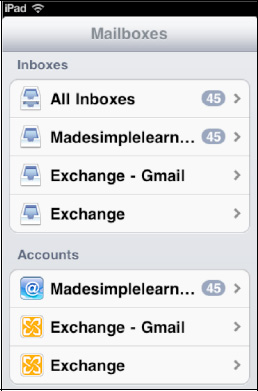
You can view your mail in a unified inbox that shows all your email accounts in a single inbox or lists each account separately. You can also choose to view any mail account folders that are synced to your iPad.
It's good to get a mental picture of your various email accounts. Your Mailboxes screen sits at the top an upside-down tree. You can access each inbox can by clicking Inboxes at the top, or you can dig into the various synced mail folders (including your inboxes) by tapping the Accounts listed at the bottom (see Figure 13–4).

Figure 13–4. Navigating to various inboxes and mail account folders
Unified Inbox
From the Mailboxes screen, tap All Inboxes to view a single inbox that contains email from every one of your accounts together.
TIP: Here's how you get to the Mailboxes screen.
If you happen to be viewing an inbox or another mail folder, you will have to tap the button in the upper-left corner of the screen once or twice.
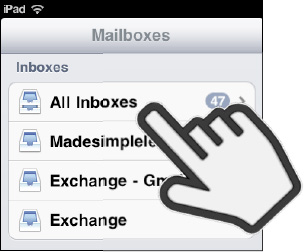
NOTE: You will only see those mail folders you have chosen to sync during the mail setup process. For example, you might have 20 mail folders on your main mail account, but you might only see a few folders on your iPad. The default synced mail folders are Inbox, Sent, Draft, and Deleted Items.
Related Messages Are Kept Together in Threads
You will also notice that some messages show a number and a right-facing Arrow icon (>) to the right of the message, like this: ![]()
This shows that there are two related messages (replies and forwards) to the message shown.
Tap any message to open it. The only time it will not open is if there are related messages. In that case, you will first see a screen with all the related messages. Tap any of those messages to open and view it (see Figure 13–5).
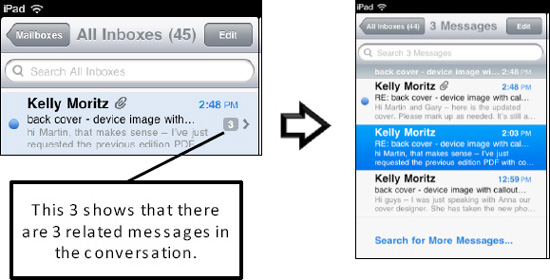
Figure 13–5. Related messages are kept together in groups called threads.
TIP: You can disable this Threaded view in your Settings app. Tap Settings ![]() Mail, Contacts, Calendars, and set Organize by Thread to OFF.
Mail, Contacts, Calendars, and set Organize by Thread to OFF.
Zooming In or Out
As when reading other text on your iPad, you can zoom in to see your email in larger text. You can do this by double-tapping the screen. You can also use the Pinch open or closed gesture to zoom in or out (see the “Zooming” section in our Quick Start Guide in Part 1 of this book for more information on these features).
Go to Next Message or Previous Message
In Portrait view, tap the Up Triangle icon ![]() or Down Triangle icon
or Down Triangle icon ![]() next to the Inbox button in the upper-right corner.
next to the Inbox button in the upper-right corner.
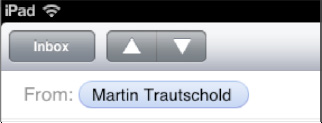
In Landscape view, you can simply tap the message in the left column to view it in the main (right column) preview window.
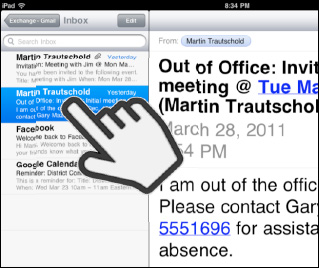
Copy and Paste
Here are a few tips to select text or pictures and then copy them from an email message:
- Double-tap the desired text to select a word, and then drag the blue handles up or down to adjust the selection.
Next, select Copy.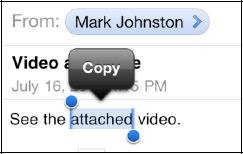
- Press and hold the text, and then choose Select or Select All.
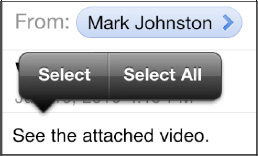
- Press and hold an image, and then select Save Image or Copy.
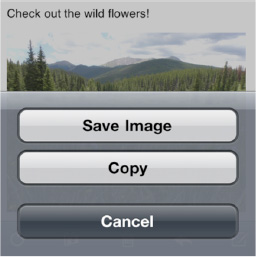
For a more complete description, please check out the “Copy and Paste” section in Chapter 2: “Typing Tips, Copy/Paste, and Search.”
Move (File) a Message
Sometimes, you may want to organize your email for easy retrieval later. For example, you might receive an email about an upcoming trip and want to move it to the Travel folder. Sometimes you receive emails that require attention later, in which case you can move them to the Requires Attention folder. This can help you remember to work on such emails later.
To start moving a message, tap the Move icon in the upper-right corner of the screen.
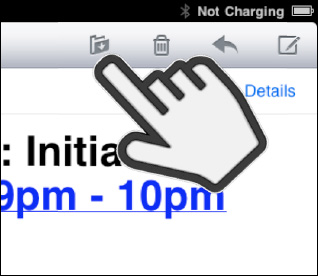
The list of folders for your current mail account will appear in the left side of the screen.
Tap the folder to which you want to move the message.
TIP: While you can move messages to the Spam folder, we recommend instead that you simply delete these messages.
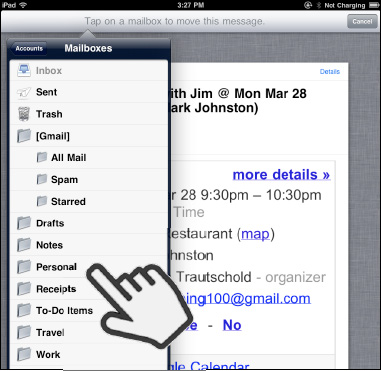
Move (File) a Bunch of Messages
To move many messages at once, open up the Inbox and follow these steps:
- Tap the Edit button in the upper-right corner of the Inbox (see Figure 13–6).
- Tap any message to select it—you see a Red Checkmark icon appear next to a message when it is selected.
- Tap the Move button at the very bottom of the screen.
- Now a list of folders will appear that you have synced from your Mail account. In Figure 13–6, we have a number of folders; however, you may only see two (depending on how your iPad is set up): Mail and Trash.
TIP: You may be able to set up additional mail folders to sync in your Settings app. Tap Mail, Contacts, Calendars, then tap the account you wish to adjust. If you see a Mail Folders to Push option, then tap that and make adjustments. If you do not see that option, then you cannot sync additional mail folders with your particular account.
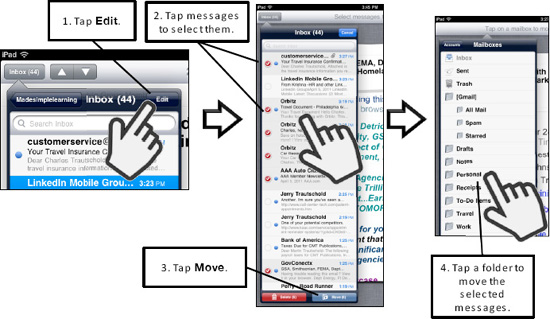
Figure 13–6. Moving a number of messages at once
Delete a Single Message
There are a few ways to delete a message.
While viewing a message, tap the Trash Can icon ![]() in the upper-right corner of the screen.
in the upper-right corner of the screen.
The message will shrink, the garbage can lid will open, the message will fly into the can, and the lid will close. It's sort of fun—give it a try!
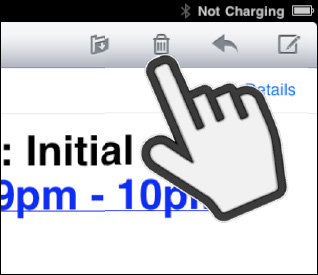
The other way to delete an individual message is from the Inbox.
Simply swipe left or right over the message until you see the Delete button appear.
Then, tap the Delete button.
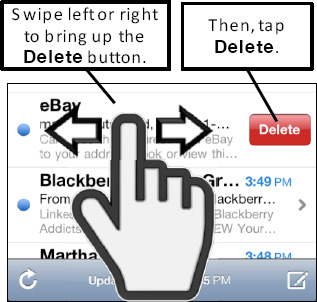
TIP: You can use the Settings app to make your iPad ask you before deleting email. To do so, tap Mail, Contacts, Calendars and set the switch next to Ask Before Deleting to Yes.
Deleting a Bunch of Messages
To delete many messages at once, open up the Inbox and use the techniques previously described to move a number of messages into a different mail folder:
- Tap the Edit button in the upper-right corner of the Inbox (see Figure 13–7).
- Tap any message to select it—you will see a Red Checkmark icon appear next to the message when it is selected.
- Tap the Delete button at the very bottom of the screen.
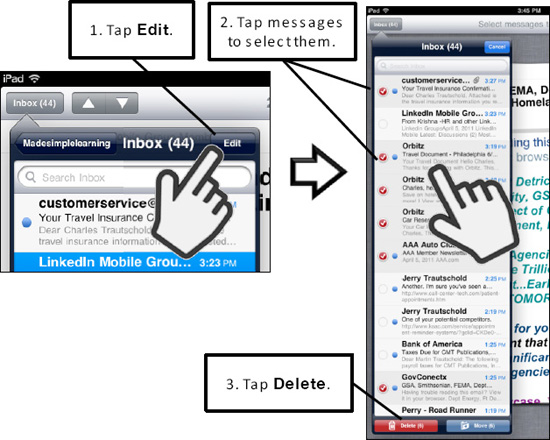
Figure 13–7. Moving a number of messages at once
Reply to Messages
You will probably use the Reply command most frequently. Follow these steps to respond to an email on your iPad:
- While reading the mail message, touch the Rounded Arrow icon in the upper-right corner.
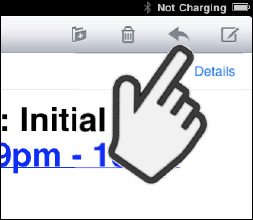
- Tap Reply or Reply All from the dropdown list of buttons.
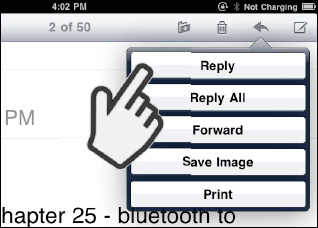
- Type your reply and press Send in the upper-right corner.

Using Reply All
Using the Reply All option is just like using the Reply function, except that all of the original recipients of the email and the original sender are placed in the address lines. The original sender will be in the To: line, while all other recipients of the original email will be listed on the Cc: line. You will only see the Reply All option if more than one person received the original email.
CAUTION: Be careful when you use Reply All. This can be dangerous if some of the recipients are not shown on the original email because they stretch off the edge of the screen. If you do use Reply All, then make sure you check the To: and Cc: lists to make sure everyone should be receiving your reply.
Forward Messages
Sometimes, you get an email that you want to send to someone else. The Forward command will let you do that (see the “Email Attachments” section in this chapter for more about working with attachments).
NOTE: You need to forward attachments to send them to others. If you want to send someone an attachment from an email you receive, you must choose the Forward option. (Note that choosing the Reply and Reply All options will not include the original email attachment(s) in your outgoing message.)
Just as when using Reply, you first tap the Rounded Arrow icon in the upper-right corner, then tap Forward from the dropdown list of buttons.
You may be prompted to address whether you want to include attachments (if there were any) from the original message.
At this point, you follow the same steps described previously to type your message, add recipients, and send it.
Print Messages
You can now print messages from your iPad, as long as you have an Apple AirPrint-compatible printer or a printer that can receive email messages and print the attachments. In this section, we will show you the way to print a message using Apple's AirPrint. Here is a list of AirPrint-compatible printers at the time of publishing (see Table 14–1). Our testing was done with the HP Photosmart e-AiO (D110a) printer.
Table13–1. A List of AirPrint-Compatible Printers
| HP Envy eAll-in-One series (D410) | HP LaserJet Pro CM1415fnw Color Multifunction Printer |
| HP Photosmart Plus e-AiO (B210) | HP LaserJet Pro CP1525n Color Printer |
| HP Photosmart Premium e-AiO (C310) | HP LaserJet Pro CP1525nw Color Printer |
| HP Photosmart Premium Fax e-AiO (C410) | HP Officejet 6500A e-AiO |
| HP Photosmart e-AiO (D110) | HP Officejet 6500A Plus e-AiO |
| HP Photosmart Wireless e-AiO (B110)—Europe and Asia-Pacific | HP Officejet 7500A Wide Format e-AiO |
| HP Photosmart eStation (C510) | HP Officejet Pro 8500A e-AiO |
| HP LaserJet Pro M1536dnf Multifunction Printer | HP Officejet Pro 8500A Plus e-AiO |
| HP LaserJet Pro CM1415fn Color Multifunction Printer | HP Officejet Pro 8500A Premium e-AiO |
Step 1: Connect Your AirPrint-Compatible Printer to the Network
Before you can print to your printer, you need to connect it to the same wireless Wi-Fi network as your iPad. Wi-Fi network securities vary, so we did not include detailed steps to do so in this book. Please use the instructions that came with your printer to connect it to your network.
Step 2: Print from your iPad
Printing is easy and straightforward. Follow these steps to do so:
- Open the mail message you wish to print.
- Tap the Rounded Arrow icon in the upper-right cornerand select Print.
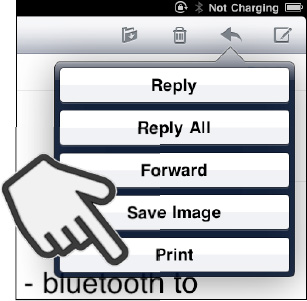
- Tap Printer to select your printer from the network. (You'll only need to do this once because the iPad remembers your selection.)

- Once selected, the printer name will appear. Adjust the number of copies using the Plus (+) and Minus (-) buttons.
- When you are ready to print, tap Print and your document will be printed wirelessly on your printer.
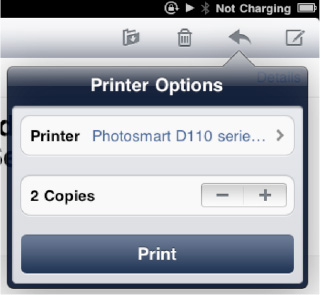
Checking on Your Printing Documents
You can check on the status of your printing documents using the Print Center app. Follow these steps to do so:
- Double-tap the Home button until you see the gray bar (multitasking window) of icons appear at the bottom of the screen.
- You can see the active print jobs and, if you desire, stop the printing using the Cancel Printing button.
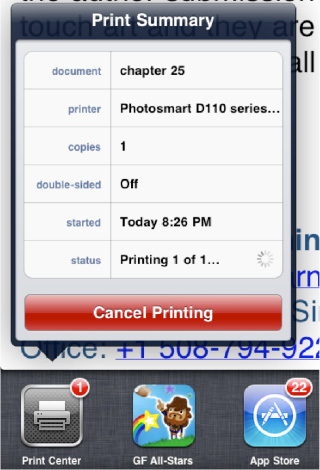
Compose a New Message
From any mail screen, tap the Compose icon in the upper-right corner to start writing a new email message.
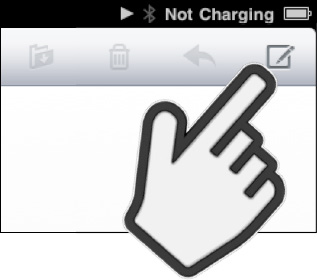
Address the Message
You have a few options for selecting recipients, depending on whether the person is in your Contact list on your iPad:
Option 1: Type a few letters of someone's first name, then hit the Space key and then type a few letters of that person's last name. The person's name should appear in the list; tap that person's name to select that contact.
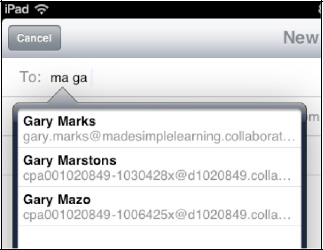
Option 2: Type an email address. Notice the @ and Period (.) keys on the keyboard, which help your typing.
TIP: Press and hold the Period key to see .com, .edu, .org, and other email domain name suffixes.

Option 3: Hit the Plus (+) sign ![]() to view your entire Contact list and search or select a name from it.
to view your entire Contact list and search or select a name from it.
If you want to use a different contact group, tap the Groups button in the upper-left corner.
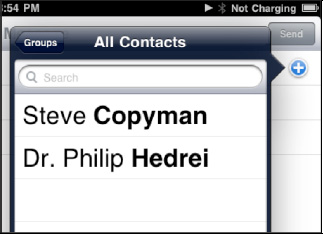
Deleting a Recipient
If you need to delete a name from the recipients list (To:, Cc:, or Bcc:), tap the name to select it ![]() and hit the Backspace key
and hit the Backspace key ![]() .
.
TIP: If you want to delete the last recipient you typed (and the cursor is sitting next to that name), hit the Delete key once to highlight the name and hit it a second time to delete it.
Adding a CC or BCC Recipient
 To add a carbon copy (Cc:) or blind carbon copy (Bcc:) recipient, you need to tap the Cc:/Bcc: field just under the To: field at the top of the email message. Doing so opens up the tapped field.
To add a carbon copy (Cc:) or blind carbon copy (Bcc:) recipient, you need to tap the Cc:/Bcc: field just under the To: field at the top of the email message. Doing so opens up the tapped field.
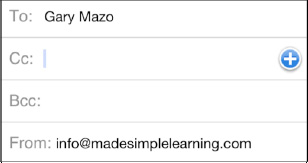
Changing the Email Account to Send From
If you have more than one email account set up, the iPad will use whichever account is set as the default account. (This is set in Settings(Mail, Contacts, Calendars(Default Account at the bottom of the Mail section.)
Follow these steps to change the email account you send from:
- Tap an email's From: field to highlight it.
- Tap a new email account to select it.
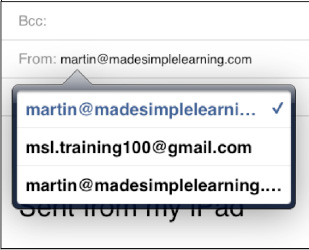
Type Your Subject
Now you need to enter a subject for your email. Follow these steps to do so:
- Touch the Subject: line and enter text for the Subject: field of the email.
- Press the Return key or tap the Body section of the email to move the cursor to the Body section.
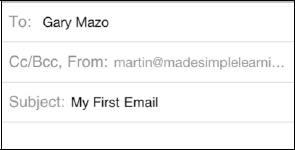
Typing Your Message
Now that the cursor is in the body of the email (under the subject line), you can start typing your email message.
Email Signature
The default email signature is shown in the image to the right: Sent from my iPad.
TIP: You can change this signature to be anything you want; see the “Changing Your Email Signature” section later in this chapter.
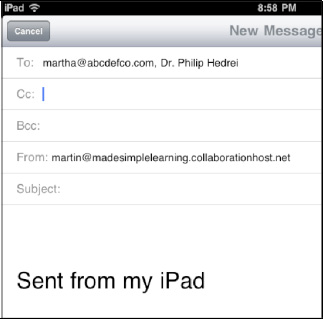
TIP: If you have larger hands, it might be easier to type when the keyboard is larger. Once you get the hang of typing on the larger keyboard with two hands, you will find that it is much faster than typing with one finger. Also, you will see auto-capitalization and auto-correction happening. Learn more about typing in Chapter 2: “Typing Tips, Copy/Paste, and Search” for more typing tips.
Send Your Email
Once you have typed your message, tap the blue Send button in the top-right corner. Your email will be sent, and you should hear the iPad's sent mail sound, which confirms that your email was sent. You can learn how to enable or disable this sound in the “Adjusting Sounds on your iPad” section of Chapter 7: “Personalize and Secure your iPad.”

Save As Draft to Send Later
If you are not ready to send your message, but want to save it as a draft message to send later, follow these steps:
- Compose your message, as described earlier.
- Press the Cancel button in the upper-left corner.
- Select the Save Draft button at the bottom of the screen.
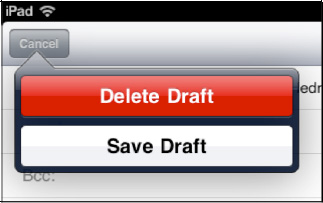
Later, when you want to locate and send your draft message, follow these steps:
- Open the Drafts folder in the email account from which you composed this message. See the “Moving Around in Mail Folders” section earlier in this chapter for help getting into the Drafts folder.
- Tap the email message in the Drafts folder to open it.
- Tap anywhere in the message to edit it.
- Tap the Send button.
Checking Sent Messages
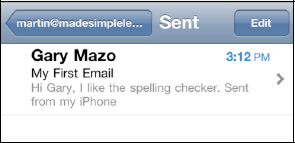
Follow these steps to confirm that the email was sent correctly:
- Tap the Email account name button in the upper-left corner to see the mail folders for the account you just used to send your message.
- Tap the Sent folder.
- Verify that that the top email you see in the list is the one you just composed and sent.
NOTE: You will only see the Sent and Trash folders if you have actually sent or deleted email from that account on the iPad. If your email account is an IMAP account, you may see many folders other than those described in this chapter.
Working With Email Attachments
Some email attachments are opened automatically by the iPad, so you don't even notice that they were attachments. Examples of these include Adobe's portable document format(PDF) files (used by Adobe Acrobat and Adobe Reader, among other apps) and some types of image, video, and audio files. You may also receive other documents as attachments, such as Apple's Pages, Numbers, and Keynote files or Microsoft's Word, Excel, and PowerPoint files. You will need to open these manually.
NOTE: You can preview many types of files—for example, word processing and spreadsheet documents—using the Quick View function. However, if you want to edit a file, you need to open it in an app that allows for editing using the Open In feature.
Knowing When You Have an Attachment
Any email with an attachment will have a little Paperclip icon next to the sender's name, as shown to the right. When you see that icon, you know you have an attachment.
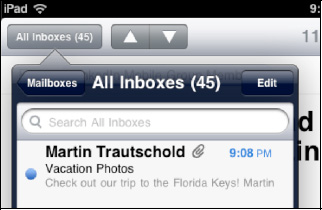
Receiving an Auto-Open Attachment
Now assume you received a few pictures or a one-page PDF file. (Multipage PDF files require that you tap to open them.)
Once you open the mail message with this kind of attachment, you will see it directly below the message.
In this example, there were several photos attached to this message that automatically opened. We just need to swipe down to see all the photos.
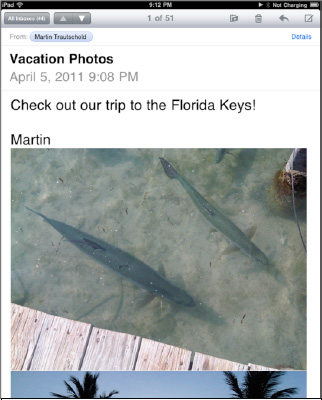
Saving Pictures You Receive
Say you liked one or more of the pictures you received. In order to save a photo on your iPad, press and hold any picture until you see a pop-up window appear.
In this example, we have four pictures, so we see Save Image, Save 4 Images, and Copy.
These images will be in your Photos app in the Saved Photos album. See Chapter 16: “iPad Photography” for more information about your Photos app.

Opening Email Attachments
Instead of immediately opening in the body of the email as we just described, other types of attachments, such as spreadsheets, word processing documents, and presentation files, will need to be opened manually.
Tap for Quick Look Mode
Follow these steps to open attachments in Quick Look mode:
- Open the message with an attachment (see Figure 13–8).
- Quickly tap the attachment to instantly open it in Quick Look mode. You can navigate around the document. Remember you can zoom in or out and swipe up or down.
- If you open a spreadsheet with multiple tabs or spreadsheets, you will see tabs across the top. Touch another tab to open that spreadsheet.
- When you are done looking at the attachment, tap the document once to bring up the controls, and then tap Done in the upper-left corner.
- If you have apps installed that can open the type of attachment you are viewing (in this case, a spreadsheet), then you will see an Open In button in the upper-right corner. Tap the Open In button to open this file in another app.

Figure 13–8. Quickly viewing attachments by tapping them
Opening Docs in Other Apps
You may want to open the attachment in another application. For example, you might want to open a PDF file in iBooks, Stanza, or GoodReader. Follow these steps to do so:
- Open the email message.
- Press and hold the attachment until you see the pop-up window.
- Select the Open In option.
- Select the application you would like to use from the list (see Figure 13–9).
- Finally, you can edit the document, save it, and email it back to the sender.

Figure 13–9. Opening and viewing attachments in other apps
Viewing a Video Attachment
You may receive a video as an attachment to an email. Certain types of videos can be viewed on your iPad (see the “Supported Email Attachment Types” section later in this chapter for a list of supported video formats). Follow these steps to open a video attachment:
- Tap the video attachment to open it and view it in the video player.
- When you are done viewing the video, tap the screen to bring up the player controls.
- Tap the Done button in the upper-left corner to return to the email message.
Opening and Viewing Compressed .zip Files
Your iPad will not be able to open and view a compressed file of .zip format unless you install an app such as GoodReader. At the time of publishing, GoodReader was still a free app and well worth installing. Follow these steps to use GoodReader:
TIP: Learn how to install and use GoodReader in Chapter 26: “New Media: Reading Newspapers, Magazines, and More.”
- Install the free GoodReader from the App Store.
- Open the email message with the
.zipfile attachment. - Touch and hold the
.zipattachment until you see a pop-up window at the bottom with a button that says, “Open in GoodReader.” Tap that button to open the.zipin GoodReader.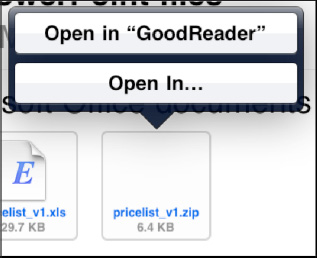
CAUTION: Do not just quickly tap the attachment to open it. At the time of publishing, this resulted in a blank white or black screen with nothing happening. Make sure to touch and hold the attachment until you see the button pop-up.
- GoodReader should now open, and your
.zipfile should be at the top of the list of files. To open or uncompress the.zipfile, tap the file and select the Unzip button.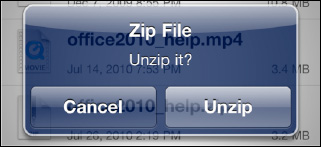
- Now you should see the uncompressed file—in this case, an Adobe
.pdffile in the list of files above the.zipfile. - Tap that uncompressed file to view it.

- When you are done reading the attachment, double-click your Home button and tap the Mail icon to return to your reading your email.
Issues When Opening Email Attachments
Some types of attachments cannot be opened on your iPad. Such attachments show up with a Question Mark (?) icon. In this image, we tried to click an attachment of the type winmail.dat, which failed.

Supported Email Attachment Types and Audio/Video Formats
Your iPad supports the following file types as attachments:
.docand.docx(Microsoft Word documents).htmand.html(web pages).key(a Keynote presentation document).numbers(an Apple Numbers spreadsheet document).pages(an Apple Pages document).pdf(Adobe's portable document format, used by programs such as Adobe Acrobat and Adobe Reader).pptand.pptx(a Microsoft PowerPoint presentation document).txt(a text file).vcf(a contact file).xlsand.xlsx(a Microsoft Excel spreadsheet document).mp3and.mov(audio and video formats).zip(compressed files). Note that these are only readable if you have an app installed that can read them, such as GoodReader (see the “Opening and Viewing Compressed .zip Files” section in this chapter.
Your iPad also supports the following audio formats:
- HE-AAC (V1)
- AAC (16 to 320 Kbps)
- Protected AAC (from iTunes Store)
- MP3 (16 to 320 Kbps)
- MP3 VBR
- Audible (formats 2, 3, and 4)
- Apple Lossless
- AIFF
- WAV
Your iPad also supports the following video formats:
- H.264 video up to 720p at 30 frames per second
- Main Profile level 3.1 with AAC-LC audio up to 160 Kbps, 48kHz
- Stereo audio in
.m4v,.mp4, and.movfile formats - MPEG-4 video, up to 2.5 Mbps, 640 by 480 pixels, and at 30 frames per second
- Simple Profile with AAC-LC audio up to 160 Kbps, 48kHz, stereo audio in
.m4v,.mp4, and.movfile formats - Motion JPEG (M-JPEG) up to 35 Mbps, 1280 by 720 pixels, 30 frames per second, and audio in ulaw
- PCM stereo audio in
.avifile format
Searching for Email Messages
The iPad has some good built-in search functionality to help you find your emails. You can search your Inbox by the From, To, Subject, or All fields. This helps you quickly locate exactly the messages you want to find.
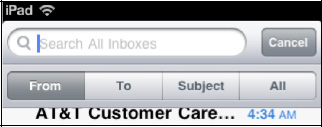
Activating Email Search
You can search an individual inbox, or search all inboxes together by going to the universal inbox (All Inboxes).
If you scroll up to the top, you will now see the familiar Search bar at the top of your Inbox (see Figure 13–10).
If your email account supports the feature, you can also search the server for email messages. At the time of writing, a few of the supported types of searchable email accounts include Exchange, MobileMe, and Gmail IMAP. Follow these steps to search through your email on a server:
- Touch the Search bar to see a new menu of soft keys under the Search bar.
- Type the text you wish to search for.
- Touch one of the soft keys under the Search window:
- From: Searches only the sender's email addresses.
- To: Searches only the recipients' email addresses.
- Subject: Searches only message Subject fields.
- All: Searches every part of the message.
For example, assume I want to search my Inbox for an email I received from Martin. I would type Martin's name into the Search box and then touch From. My Inbox would then be filtered to show only the emails from Martin.
NOTE: If you have multiple email accounts, you will not be able to search all of your inboxes at the same time because your iPad only lets you search one inbox at a time. For a more global search on your iPad, use the Spotlight Search feature shown in the “Finding Things with Spotlight Search” section of Chapter 2: “Typing Tips, Copy/Paste, and Search.”

Figure 13–10. Searching for email using the From, To, Subject, or All text fields
Fine-Tuning Your Email Settings
You can fine-tune your email accounts on your iPad with the myriad options available in the Settings app.
Follow these steps to change these settings:
- Tap the Settings icon.
- Tap Mail, Contacts, Calendars.
The sections that follow explain the adjustments you can make.
Automatically Retrieve Email (Fetch New Data)
In addition to the options under Advanced, you can use the Email settings to configure how often your email is fetched, or pulled, to your iPad. By default, your iPad automatically receives mail or other contact or calendar updates when they are pushed from the server.
You can adjust this setting by taking the following steps:
- Touch the Settings icon.
- Touch Mail, Contacts, Calendars.
- Touch Fetch New Data under the email accounts listed.
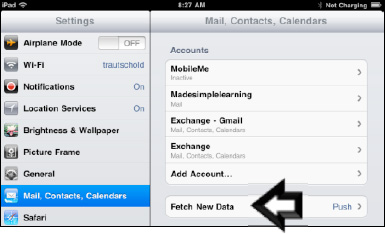
- Set Push to ON (default) to automatically have the server push data. Turn It OFF to conserve your battery life.
- Adjust the timing schedule to pull data from the server. This is how frequently applications should pull new data from the server.
NOTE: If you set this option to Every 15 Minutes, you will receive more frequent updates, but sacrifice battery life compared to a setting of Hourly.

Having automatic retrieval is very handy if you just want to turn on your iPad and see that you have messages; otherwise, you need to remember to check.
Advanced Push Options
At the bottom of the Fetch New Data screen, below the Hourly and Manually settings, you can touch the Advanced button to see a new screen with all your email accounts listed.
Tap any email account to adjust its settings.
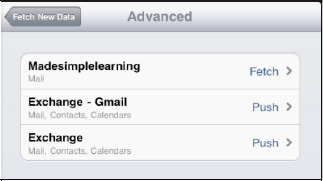
Most accounts can be Fetched on the schedule you set or set to Manual. The Manual option requires that you retrieve data using the Update button. This screen gives you the ability to adjust Fetch, Manual, or in some cases Push settings for each account you have set up.
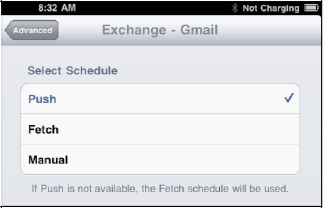
Adjusting Your Mail Settings
Under the Accounts section, you can see all the email settings listed under Mail. The Default settings may work well for you; but if you need to adjust any of these, you can follow these steps.
Show: This sets how many emails are pulled from the server. You can specify anywhere from 25 to 200 messages (the default is 50 recent messages).
Preview: This option lets you set how many lines of text in addition to the Subject are shown in the Inbox preview. You can adjust this value from None to 5 Lines (the default is 2 Lines).
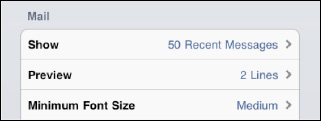
Minimum Font Size: This is the default font size shown when opening an email for the first time. It is also smallest font size that you are allowed to zoom out to when viewing an email. Your options are Small, Medium, Large, Extra Large, and Giant (the default is Medium).
Show To/Cc Label: With this option ON, you will see a small To or Cc label in your Inbox before the subject. This label shows which field your address was placed in (the default state of this option is OFF).

Ask Before Deleting: Turn this option ON to be asked every time you try to delete a message (the default is OFF).
Load Remote Images: This option allows your iPad to load all the graphics (remote images) that are placed in some email messages (the default value for this option is ON).

Organize by Thread: This option groups related emails together. It shows only one message, with a number next to it. That number indicates how many related emails exist. This feature gives you a good way to keep all discussions together in one place (the default value of this option is ON).
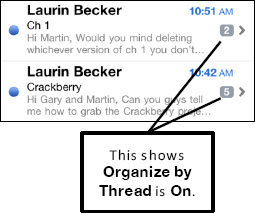
Always Bcc Myself: This option sends a blind carbon copy (Bcc:) of every email you send from your iPad to your email account (the default value of this option is OFF).
![]()
Changing Your Email Signature
By default, emails you send will say “Sent from my iPad.” Follow these steps to change the Signature line of the email:
- Tap the Signature tab.

- Tap the Clear button and type in the new email signature you would like to appear at the bottom of all emails sent from your iPad.
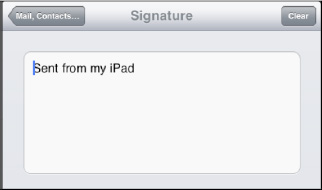
- When you are done editing the Signature field, tap the Mail, Contacts… button in the upper-left corner. This will return you to the Mail settings screen.
Changing Your Default Mail Account (Sent From)
If you have multiple email accounts set up on your iPad, you should set one of them—usually, the one you use most—as your Default Account. When you select Compose from the Email screen, the default account is always chosen. Also, if you click an email address in any other app to compose a new message, this Default Account will be selected. Follow these steps to change the email account you send from by default:
- Tap the Default Account option, and you will see a list of all your email accounts.

- Tap the one you wish to use as your Default Account choice.

- When you are done, touch the Mail, Contacts…button to return to the Mail settings menu.
Toggling Sounds for Receiving and Sending Email
You may notice a little sound effect every time you send or receive email. What you hear is the default setting on your iPad.
If you want to disable this option or change it, you do so in the Settings program:
- Tap your Settings icon.
- Tap General in the left column.
- Tap Sounds in the right column.
- You will see various switches to turn sound effects on or off. Tap New Mail and Sent Mailto adjust the ON orOFF options.
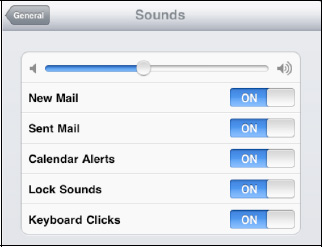
Advanced Email Options
NOTE: Email accounts set up as Exchange, IMAP, or MobileMe will not have this Advanced email settings screen. This only applies to POP3 email accounts.
To get to the Advanced options for each email account, follow these steps:
- Touch the Settings icon.
- Touch Mail, Contacts, Calendars.
- Touch an email address listed under Accounts.
- At the bottom of the mail settings pop-up window, tap the Advanced button to bring up the Advanced dialog.
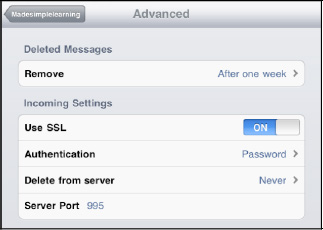
Removing Email Messages from the iPad After Deletion
You can select how frequently you want email removed completely from your iPad once it is deleted.
Touch the Remove tab and select the option that is best for you; the default setting is Never.
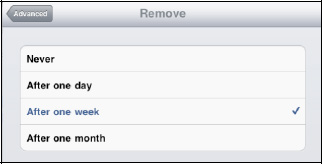
Using SSL/Authentication
SSL/Authentication features were discussed previously, but the Advanced email options screen supplies another location to access these features for a particular email account.
Deleting Messages from the Server
You can configure your iPad to handle the deletion of messages from your email server. Usually, this setting is left at Never, and this function is handled on your main computer. If you use your iPad as your main email device, however, you might want to handle that feature from the phone itself. Follow these steps to use your iPad to remove deleted emails on the server:
- Touch the Delete from Server tab to select the feature that best suits your needs: Never, Seven Days, or When removed from Inbox.
- The default setting is Never. If you want to choose Seven Days, that option should give you enough time to check email on your computer, as well as your iPad, and then decide what to keep and what to get rid of.
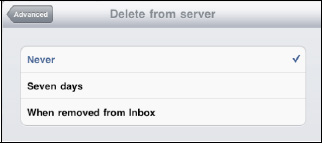
Changing the Incoming Server Port
As you did with the Outgoing Server Port earlier, you can change the Incoming Server Port if you are having trouble receiving email. It is very rare that your troubles will be related to the port you receive mail on, which means that you will rarely need to change this number. If your email service provider gives you a different number, just touch the numbers and input a new port. The value for an Incoming Server Port is usually 995, 993, or 110; however, the portvalue could also be another number.
Troubleshooting Email Problems
Usually, your email works flawlessly on your iPad. Sometimes—whether it is a server issue, a network connectivity issue, or an email service provider requirement—email may not work as flawlessly as you would hope.
More often than not, there is a simple setting that needs to be adjusted or a password that needs to be re-entered.
If you try out some of the troubleshooting tips that follow and your email is still not working, then your email server may just be down temporarily. Check with your email service provider to make sure your mail server is up and running; you might also check whether your provider has made any recent changes that would affect your settings.
TIP: If these tips that follow do not solve the problem, please check out Chapter 28: “Troubleshooting” for more helpful tips and resources.
Email Isn't Being Received or Sent
If you can't send or receive email, your first step should be to verify you are connected to the Internet. Look for Wi-Fi or 3G connectivity in the upper-left corner of your Home screen (see the “How Do I Know When I'm Connected?” section of “Quick Start Guide” for details.
Sometimes, you need to adjust the outgoing port for email to be sent properly. Do so by following these steps.
- Tap Settings.
- Touch Mail, Contacts, and Calendars.
- Touch your email account that is having trouble sending messages under Accounts.
- Touch SMTP and verify that your outgoing mail server is set correctly; also check that it is set to ON.
- Touch Outgoing Mail Server at the top and verify all the settings, such as Host Name, User Name, Password, SSL, Authentication, and Server Port. You might also try 587, 995, or 110 for the Server Port value; sometimes that helps.
- Click Done and the email account name in the upper-left corner to return to the Email settings screen for this account.
- Scroll down to the bottom and touch Advanced.
- You can also try a different port setting for the server port on this screen, such as 587, 995, or 110. If those values don't work, contact your email service provider to get a different port number and verify your settings.
Verifying Your Mail Account Settings
Follow these steps to verify your account settings:
- Tap the Settings icon.
- Tap Mail, Contacts, Calendars.
- If you received an error message from a particular email account, touch that that account.
- Verify that the Account is set to ON.
- Verify that your email Address is correct in the POP Account Information section.
- Verify that all the information in the Host Name, User Name, and Password fields is correct.
- If you received an error message while trying to send an email, the issue will be most likely in the SMTP settings in your Outgoing Mail Server area.
- Tap SMTP to adjust more settings.
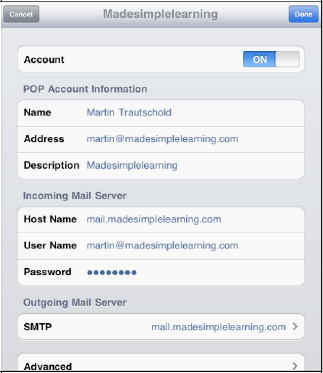
- Touch the Primary Server tab and make sure that it is set to ON.
- Underneath the Primary Server tab, you will see other SMTP servers that are used for your other email accounts. One option is to use one of the other SMTP servers that you know is working. In that case, just touch the tab for that server and turn that switch to ON.
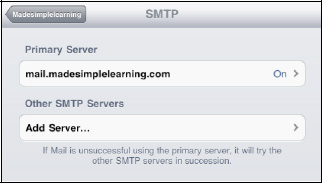
- Tap the Primary Server address to view and adjust more settings.
- Verify that the Primary Server is ON.
- Contact your email service provider to verify other settings, such as Host Name, User Name, Password, SSL, Authentication, and Server Port. We will share more details and some tips about these settings in the sections that follow.
- Tap the Done button when finished and then tap the button with your email account listed in the upper-left corner to return to previous screens. Or, you can tap the Home button to exit to your Home screen.
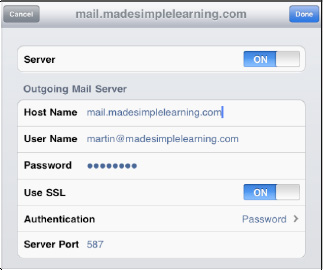
Using SSL
Some SMTP servers require the use of Secure Socket Layer (“SSL”) security. If you are having trouble sending email and the Use SSL switch is set to OFF, try setting it to ON to see if that helps.
Changing the Method of Authentication
Under the SSL switch is an Authentication tab. Usually, Password is the correct setting for this switch. We don't recommend that you change this setting unless you have specific directions from your email service provider to make a change.
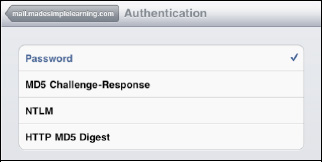
Changing the Server Port
Most often, when you configure your email account, the server port is set for you. Sometimes, there are tweaks that need to be made that are specific to your ISP.
If you have been given specific settings from your ISP, you can change the server port to try to alleviate any errors you might be seeing. Follow these steps to change the Server Port settings:
- Go back to the specific SMTP settings for your account.
- Touch the tab for the Primary Server, as you did in the “Verify Mail Account Settings” section.
- Scroll down to Server Port and touch the screen on the number indicated.
- This causes a keyboard to pop up that you can use to input a new port number (the one given you by your ISP). Most often, the number provided by your ISP will be 995, 993, 587, or 110; however, if you're given a different number, just input it.
- When you are done, touch the SMTP tab in the upper-left corner to return to the previous screen.
